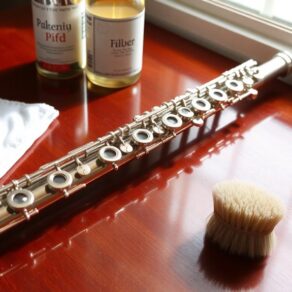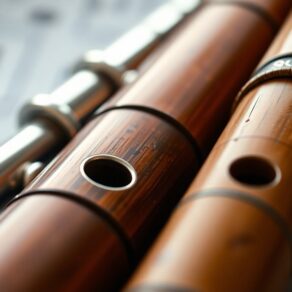In classical music, you'll encounter ten distinct flute variants, each with unique characteristics and sound qualities. The concert flute serves as the primary orchestral instrument, while the piccolo delivers a bright, penetrating tone. The alto and bass flutes provide warmth and depth, adding richness to ensemble performances. Historical flutes like the Renaissance and Baroque flutes reflect earlier design innovations and stylistic nuances. Additionally, wooden and Native American flutes offer cultural dimensions and distinct timbres. Each variant shapes the musical landscape, showcasing versatility and expressive potential. Explore these flutes further to enhance your understanding of their roles in classical music.
Key Takeaways
- The concert flute is the most prominent variant, essential in orchestral and solo performances, with a rich repertoire across various musical styles.
- The piccolo, known for its bright and penetrating sound, plays a vital role in orchestras and chamber music, often featuring in works by Mozart.
- The alto flute offers a warm and deep tonal palette, frequently utilized in chamber music settings and showcasing diverse repertoire from classical to contemporary.
- The bass flute adds richness to ensembles, pitched an octave lower than the concert flute, and is noted for its warm, mellow sound and extended techniques.
- The contrabass flute, the largest member of the flute family, provides extraordinary tonal depth and requires mastery of embouchure control for optimal sound production.
Concert Flute

The concert flute, often regarded as the most prominent member of the flute family, plays an essential role in orchestral and solo performances alike. As you explore concert flute techniques, you'll discover the instrument's versatility and expressive potential. Mastery of these techniques, such as breath control, articulation, and vibrato, is vital for achieving the nuanced sound that defines this instrument.
Each technique enhances your ability to convey emotion and connect with your audience.
When delving into the concert flute repertoire, you'll find a rich selection of compositions spanning various musical styles and eras. From Baroque masterpieces by composers like J.S. Bach to Romantic works by composers such as Gabriel Fauré, the repertoire showcases the concert flute's lyrical qualities and technical capabilities.
Engaging with this diverse repertoire not only expands your musical vocabulary but also deepens your understanding of the instrument's historical context and evolution.
As you practice and perform, consider how the concert flute's unique sound complements the orchestral ensemble. Its ability to soar above other instruments while blending seamlessly in harmony highlights the importance of both individual technique and collaborative musicianship. Furthermore, the ability to master advanced flute techniques enhances your overall performance and artistic expression.
Through dedicated practice and immersion in the repertoire, you'll cultivate a sense of belonging within the broader flute community, connecting with fellow musicians who share your passion.
Ultimately, your journey with the concert flute will enrich your musical identity, allowing you to express your artistry in profound and meaningful ways.
Piccolo
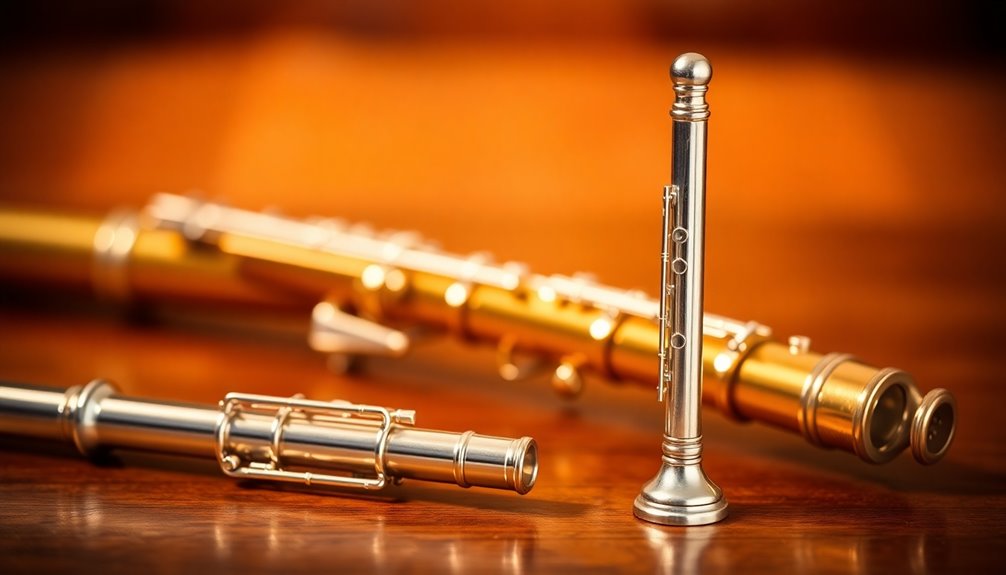
Known for its bright, penetrating sound, the piccolo occupies a unique position in the flute family. This diminutive instrument, often regarded as the "soprano" of the flute family, demands a specific set of skills and techniques that distinguish it from its larger counterparts.
You'll find that mastering piccolo techniques involves not only breath control but also precise finger coordination and an acute sense of pitch. The instrument's high register can be unforgiving, requiring you to develop a keen awareness of intonation and articulation.
Delving into the piccolo repertoire reveals a wealth of compositions that showcase its distinctive qualities. Composers like Mozart, who utilized the instrument in works such as "The Magic Flute," capitalized on its ability to soar above the orchestral texture.
You'll also encounter contemporary pieces that challenge your technical prowess while pushing the boundaries of expression.
In performance settings, the piccolo often serves as an essential color within orchestral and chamber music contexts. Its ability to cut through the ensemble can elevate passages, providing a sparkling contrast to the warmer tones of the concert flute.
As you explore the repertoire, you'll discover that the piccolo isn't merely a secondary instrument; it possesses a rich voice with the power to captivate audiences. Regular maintenance, such as using a Hodge Piccolo Swab, is vital for keeping the instrument clean and ensuring optimal performance.
Engaging with the piccolo means embracing its challenges and reveling in its unique sound world, ultimately enriching your understanding of the flute family and your musicianship.
Alto Flute

Positioned between the concert flute and the bass flute, the alto flute offers a unique tonal palette that enriches both solo and ensemble performances.
With its larger body and a lower pitch range, the alto flute captures warmth and depth, making it a valued instrument in various musical contexts. If you're exploring this fascinating variant, you'll find a wealth of alto flute techniques and repertoire that broaden your musical expression.
Here are some key aspects to contemplate:
- Tonal Quality: The alto flute's mellow sound is perfect for blending with strings and woodwinds, creating lush harmonies.
- Extended Range: It typically plays in the key of G, allowing for an expansive range that can evoke a broad emotional spectrum.
- Technique: Mastering techniques like vibrato, flutter tonguing, and harmonics can enhance your performance and showcase the instrument's capabilities.
- Repertoire: A diverse array of compositions exists, from classical pieces to contemporary works, all highlighting the alto flute's unique voice.
- Collaboration: The alto flute often appears in chamber music settings, fostering a sense of community and collaboration among musicians.
- The alto flute's rich, mellow tones contribute to a wider sonic palette in ensemble settings, adding depth and texture to the overall sound.
Bass Flute

With its distinctive lower register, the bass flute adds a rich depth to both orchestral and chamber music settings. Unlike the standard concert flute, this instrument extends the flute family's tonal palette, allowing you to investigate unique harmonies and textures. The bass flute is typically pitched an octave lower than the concert flute, which gives it a warm, mellow sound that can anchor a musical ensemble effectively.
When you begin to explore bass flute techniques, you'll find that the instrument demands specific approaches to breath control and finger positioning. The larger size can make certain technical passages more challenging, yet this also opens the door for expressive interpretations of music.
It's vital to practice extended techniques, like flutter tonguing and harmonics, which can enhance your performance and broaden the instrument's expressive capabilities.
In terms of bass flute repertoire, you'll discover a wealth of compositions that highlight its unique voice. From contemporary works to arrangements of classical pieces, the bass flute often plays a significant role in chamber music, providing both harmonic support and melodic lines.
Composers like Edgard Varèse and Paul Hindemith have written notable works that showcase the bass flute's distinctive timbre and versatility. Additionally, the bass flute is increasingly recognized in modern orchestral compositions, providing unique tonal colors that enrich the overall sound.
As you engage with this instrument, you'll not only deepen your understanding of its techniques and repertoire, but also cultivate a sense of belonging within the broader community of flute players who appreciate its unique contributions to classical music.
Contrabass Flute

The contrabass flute, an even larger member of the flute family, takes the bass flute's rich tonal qualities to an extraordinary depth. With its unique capabilities, this instrument opens new avenues for exploration within the domain of classical music. Its low register, often described as both warm and resonant, invites you to explore a diverse repertoire that showcases its potential.
Understanding contrabass flute techniques is fundamental for maximizing your performance. You'll find that mastering these techniques not only enhances your playing but also enriches your musical expression. Here are some key aspects to reflect on:
- Embouchure Control: Developing a strong embouchure is essential for achieving the desired tone and intonation.
- Breath Support: Proper breath control allows for sustained notes and dynamic range, significant for performing longer passages.
- Articulation: Experiment with various articulation styles to bring out the nuances in your playing.
- Extended Techniques: Investigate multiphonics and other avant-garde methods that can add texture to your sound.
- Repertoire Selection: Diversifying your repertoire can help you discover the full range of the contrabass flute's capabilities.
The contrabass flute, along with its counterparts like the bass flute and alto flute, contributes to the richness of the woodwind section in orchestras. Incorporating these elements into your practice won't only elevate your skills but also deepen your connection to the music. As you engage with the contrabass flute repertoire, you'll find a community of musicians who share your passion, enriching your journey through this remarkable instrument.
Irish Flute
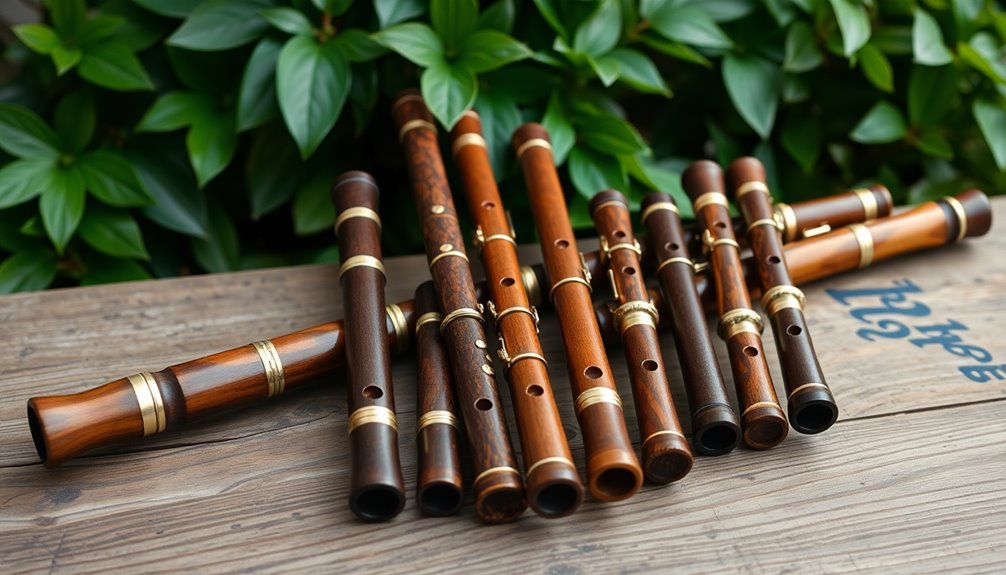
Exploring the Irish flute reveals a vibrant connection to traditional music, characterized by its distinct timbre and expressive capabilities. The Irish flute, often made from wood, has a rich history that intertwines with the cultural tapestry of Ireland. Emerging in the early 19th century, it evolved from earlier instruments like the simple-system flute, becoming essential in traditional Irish music.
As you engage with the Irish flute, you'll notice its unique construction features, including a cylindrical body and a wider embouchure hole. These elements contribute to its warm, resonant sound, allowing musicians to perform expressive ornamentations that are the hallmark of traditional Irish melodies.
You might find it fascinating that the flute's popularity surged during the Irish folk revival in the 1960s, as musicians sought to reclaim and celebrate their cultural heritage.
The repertoire you encounter while exploring this instrument includes jigs, reels, and airs, reflecting the lively spirit of traditional Irish music. You'll appreciate how the Irish flute facilitates a deep emotional connection during performances, whether in intimate sessions or vibrant festivals.
Moreover, understanding the Irish flute's history enriches your appreciation of its role in community gatherings, where music serves as a unifying force. As you immerse yourself in this tradition, you'll discover that playing the Irish flute isn't just about mastering techniques; it's about becoming part of a lineage that values storytelling through music and fosters a sense of belonging among its practitioners. Additionally, the choice of wood materials significantly influences the flute's tonal quality and resonance, enhancing the overall musical experience.
Renaissance Flute

Diving into the world of the Renaissance flute reveals its significant role in the evolution of woodwind instruments during the late Middle Ages and early modern period. This period saw the flute transform from a simple, rudimentary instrument into a more sophisticated and expressive tool for musicians.
The Renaissance flute is characterized by its conical bore and typically made of wood, which contributed to its warm, rich tone that beautifully complemented the era's music.
As you explore Renaissance music, consider the following aspects of the Renaissance flute:
- Construction: The flute was often made from a single piece of wood, enhancing tonal quality.
- Tuning: While it lacked standardized pitch, many flutes were tuned to varying temperaments, reflecting regional differences.
- Technique: Players employed a range of techniques, including breath control and fingerings, to achieve expressive dynamics.
- Repertoire: The Renaissance flute was frequently featured in ensembles, playing both melodic and harmonic roles.
- Historical Performance: Authentic performances endeavor to recreate the sound and style of this era, emphasizing the flute's unique qualities. The use of the concert flute emerged from the evolution of the Renaissance flute, showcasing its lasting influence on modern woodwind instruments.
Baroque Flute

A remarkable evolution occurred with the Baroque flute, which emerged in the late 17th century, marking a significant advancement in both design and musical capabilities. This instrument, often made of wood, featured a conical bore that allowed for a warmer, more resonant tone compared to its predecessors. The keyless design of the Baroque flute facilitated an expressive style, essential for maneuvering the intricate passages found in the Baroque repertoire.
In Baroque performance, musicians embraced ornamentation, and the Baroque flute became a vehicle for personal expression. The ability to execute trills, turns, and other embellishments provided flutists with the means to infuse their playing with emotion and individuality.
You might find it fascinating that composers like Bach and Handel wrote extensively for the flute, showcasing its versatility and expressive potential within the ensemble.
The repertoire created for the Baroque flute is rich and varied, encompassing both solo and ensemble works. As you explore deeper into this era, you'll discover that the flute often shared the spotlight with string instruments, creating a dialogue that characterized much of the music from this time.
The emergence of the Baroque flute also coincided with the development of performance practices, where understanding the nuances of articulation and dynamics became vital for interpreting the music authentically. Mastery of articulation techniques enhances the emotive quality of performances, allowing flutists to convey intention and meaning effectively.
Embracing the Baroque flute allows you to connect with a historical tradition that celebrates both technical skill and emotive power, making it a rewarding experience for any musician passionate about classical music.
Native American Flute
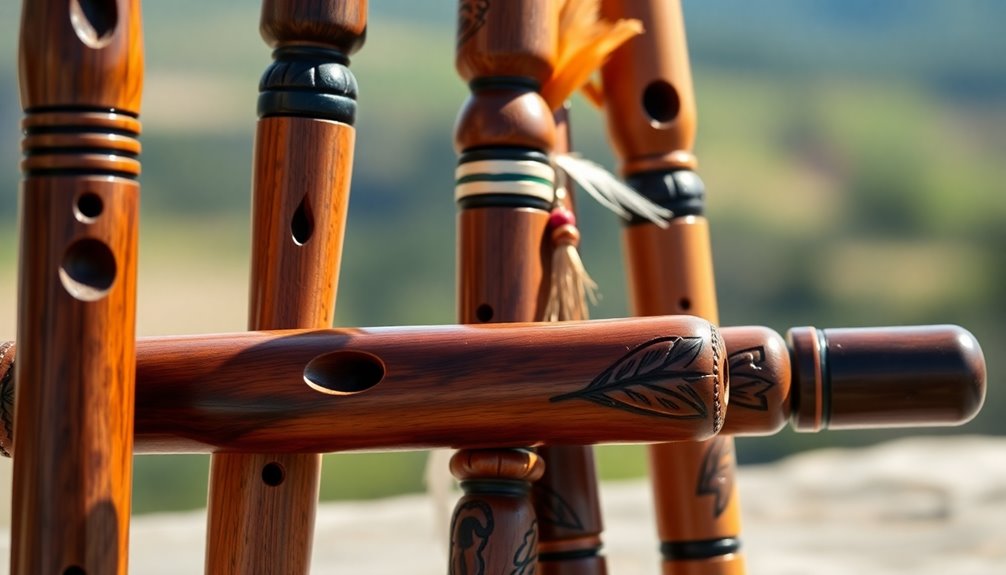
The Native American flute, with its rich cultural heritage and unique tonal qualities, represents a significant branch of woodwind instruments that has captivated musicians and listeners alike. Originating from Native American traditions, this flute embodies a deep connection to nature, spirituality, and community. Its hauntingly beautiful sound has often been used in healing music, fostering emotional and spiritual well-being.
As you explore the nuances of the Native American flute, consider these key aspects:
- Construction: Typically made from wood or bamboo, each flute is handcrafted, allowing for individual character and resonance.
- Tonal Range: The flute's pentatonic scale facilitates improvisation, making it accessible for both novice and experienced players.
- Cultural Significance: Many flutes are associated with specific tribes, each carrying its own stories and meanings, reflecting the diverse practices across Native American cultures.
- Healing Practices: The sound is believed to promote healing, often used in ceremonies and personal reflection, creating a space for emotional release.
- Community Connection: Playing the flute can enhance community bonds, whether through group performances or shared listening experiences.
Engaging with the Native American flute invites you to appreciate its artistry and the profound cultural narratives it conveys. By understanding its role in healing music and community, you can foster a deeper connection to this unique instrument, enriching both your musical journey and your appreciation for Native American traditions. Additionally, similar to the Native American flute, bamboo flutes are known for their unique sound quality, which is suitable for all skill levels.
Wooden Flute

While many woodwind instruments exist, the wooden flute stands out due to its intricate craftsmanship and warm, resonant sound. Its construction is a meticulous process that often involves selecting high-quality woods, such as grenadilla or bamboo, known for their acoustic properties.
You'll find that skilled artisans shape the body, carefully crafting the embouchure and finger holes to optimize sound production. This attention to detail not only enhances tonal quality but also influences playability, making it an instrument that feels alive in your hands.
The history of the wooden flute spans centuries, with origins tracing back to ancient civilizations. You may be surprised to learn that the wooden flute was a staple in various cultures, from the Baroque era in Europe to traditional Asian music.
Each cultural adaptation brought unique features, such as varying finger hole placements and embellishments, resulting in a rich tapestry of styles.
As you explore the wooden flute's evolution, consider how it has influenced contemporary compositions and performances. Many modern flutists embrace its expressive capabilities, utilizing it in diverse musical genres. The choice of high-quality woods significantly impacts the flute's tonal richness and durability.
The wooden flute isn't merely an instrument; it represents a connection to history and artistry. It invites you to immerse yourself in its warm timbre and to appreciate the craftsmanship that brings this timeless instrument to life.
Frequently Asked Questions
How Do Different Flute Materials Affect Sound Quality?
When you explore how different flute materials affect sound quality, you'll notice that material impact plays an essential role.
For instance, wooden flutes typically produce a warmer, richer tone compared to metal ones, which tend to offer a brighter, more focused sound.
The sound characteristics vary greatly, influencing your overall experience and expression while playing.
Each material brings its own unique qualities, allowing you to find a flute that resonates with your personal style.
What Are the Common Playing Techniques for Each Flute Variant?
When exploring common playing techniques, you'll notice that each flute variant demands unique approaches.
For instance, the traditional Western concert flute often utilizes techniques like flutter-tonguing and harmonics, while the Native American flute emphasizes breath control and expressive ornamentation.
Understanding these variant styles allows you to refine your flute techniques, enhancing your performance and connection with the music.
Each style enriches your skill set, fostering a deeper sense of belonging within the music community.
How Do Flute Variants Differ in Terms of Playing Range?
Think of each flute variant as a different vehicle on the same road, each with unique capabilities.
Some flutes, like the concert flute, excel in sound projection and possess a wide playing range, while others, like the piccolo, have a higher pitch and limited range.
Your playing techniques must adapt accordingly; mastering these nuances helps you fully appreciate the distinct sonic landscapes each flute variant offers, enhancing your connection to the music and your peers.
What Historical Periods Influenced the Design of Various Flutes?
You'll find that various historical periods profoundly shaped flute design.
The Renaissance influence emphasized soft timbres and simpler mechanisms, while the Baroque flute introduced a more elaborate structure, enhancing expressiveness and range.
As you study these developments, consider how musicians adapted their playing styles to fit these evolving instruments.
This change not only reflects technological advancements but also highlights the cultural shifts in music, inviting you to appreciate the flute's rich history.
Are There Any Modern Adaptations of Traditional Flute Variants?
Imagine a bridge connecting the past and the present. Modern flutes often showcase traditional adaptations, blending historical craftsmanship with contemporary innovation.
You'll find instruments that incorporate materials like carbon fiber or aluminum while retaining classic designs. These modern flutes enhance playability and expand tonal range, making them appealing to both seasoned musicians and beginners.
Conclusion
In exploring these ten distinct flute variants, it's clear that each brings unique tonal qualities and historical significance to classical music. Some might argue that the concert flute reigns supreme, but embracing the diversity of flutes enriches our understanding and appreciation of music as a whole. By acknowledging the varying roles and sounds of each flute type, you not only celebrate their individuality but also enhance your listening experience, allowing for a deeper connection to the music.


